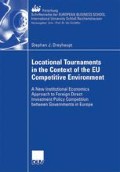Abstract
The prior discussion of institutional policy choices for FDI governance led to the conclusion that reaching agreement on any of these options — even the most simple ones such as creating a more transparent and accountable system of subsidy controls — will not take place unless there is a sufficient balance of domestic interests and power capabilities as well as an appropriate regime design that ensures mutual trust and discourages opportunistic behavior. In that context, the EU framework does not only present itself as an effective mechanism of bounded FDI competition661 but also provides important lessons on the political-economic process for reaching consensus on the choice of FDI governance model. The final section will thus review the most important factors that contributed to the process and its outcomes, both in terms of overall guiding-principles of the institutional environment (“rules of the game”) as well as the more specific governance approach (“play of the game”) that informed the EU’s course. In conclusion, recommendations will be given as to whether or not the EU approach can serve as a model for the establishment of other FDI regimes.
Access this chapter
Tax calculation will be finalised at checkout
Purchases are for personal use only
Preview
Unable to display preview. Download preview PDF.
References
FDI competition in the EU is really “bounded” in two ways: first, incentive support measures for large investment projects are confined to certain designated geographic (development) areas, and second, they are limited in terms of overall award rates by the Commission (see OMAN, 2000, p. 72)
It can be argued that the evolution of the EU framework and the shift of focus in subsidy control onto FDI competition were triggered by major external events such as capital market liberalization in the 1980s or the completion of the SEA in the 1990s, and, thus, not part of the original design as envisaged in the Treaty of Rome. See also YOUNG (1989) on the importance of external shocks on the success of regime formation.
See Wishlade in RAINES/ BROWN (1999), p. 94 who asserts that “the issue of competition for mobile investment has been the driving force behind the Commission policy in controlling general investment aid, and, in particular, regional aid”.
UNCTAD (1999), p. 27.
SEID (2000) calls this approach “regulated openness”. See also WILLIAMSON (1985) for the idea of relational dimensions of contracts, which suggests that most transactions are both reoccurring as well as asset-specific, and, thus, part of a larger network of contractual relations that, in scope and duration, no actor is able to fully predict. As a consequence, contracts do not need to anticipate and detail each and every aspect of the transactions, as a temporary advantage by one party will be offset by another advantage of the other party over time.
See RAINES/ BROWN (1999), p. 90.
See UNCTAD (1999), p. 28.
However, not all regional investment agreements have binding character, see for example the APEC Non-Binding Investment Principles of 1994 (see UNCTAD, 2003, p. 91).
KATZENSTEIN (1985), p. 39 argues that the key to small states success in Europe lies in their successful combination of international integration and flexibility with domestic forms of compensation.
See OLSON (1971) for discussion of group size in regime creation.
See CHARLTON/ CHRISTIANSEN/ OMAN (2002), p. 4.
Wishlade in RAINES/ BROWN (1999), p. 95.
The occasional critique leveled against arbitrary or opaque decision-making practice of the DG Competition (see, for example, BURNSTDE, 1998; EVANS/MARTIN, 1991) is more a function of its lack of independence — as discussed in Chapter 4 — which leads to political pressures and sometime politically influenced decisions, than an intended design feature of the Commission’s body of principles.
YOUNG (1989), p. 367.
See CHARLTON/ CHRISTIANSEN/ OMAN (2002), p. 4.
See OMAN (2000), p. 123.
See SEID (2002), p. 194.
See SMYTHE (1998), p. 99.
See CHARLTON (2003), p. 29.
See CHARLTON/ CHRISTIANSEN/ OMAN (2002), p. 14.
OMAN (2000), p. 72.
See BLOMSTRÖM/ KOKKO (1998a) for a detailed discussion of this issue. See DUNNING (1997); PAIN/LANSBURY (1997); BARRELL/PAIN (1997) for effects of European integration.
See UNCTAD (2003), p. 91. The impact of regional integration on FDI flows depends of course on a number of other economic determinants in addition to the institutional environment.
See SCHNEIDER/ WERLE (1990) for a discussion of the institutional dynamic of the European Community, and particularly the concept of the EU as a regime and corporate actor.
NORTH (1990), p. 14.
See YOUNG (1994).
RODRICK (2002), p. 1.
See RODRICK (2002), pp. 1–2.
CHARLTON (2003), p. 29. See also DONAHUE (1998).
See OMAN (2000), p. 66.
See also EU (2003a), p. 15.
Rights and permissions
Copyright information
© 2006 Deutscher Universitäts-Verlag | GWV Fachverlage GmbH, Wiesbaden
About this chapter
Cite this chapter
(2006). Is the EU Competition Framework a Model for International FDI Regimes?. In: Locational Tournaments in the Context of the EU Competitive Environment. DUV. https://doi.org/10.1007/978-3-8350-9109-2_16
Download citation
DOI: https://doi.org/10.1007/978-3-8350-9109-2_16
Publisher Name: DUV
Print ISBN: 978-3-8350-0280-7
Online ISBN: 978-3-8350-9109-2
eBook Packages: Business and EconomicsEconomics and Finance (R0)

